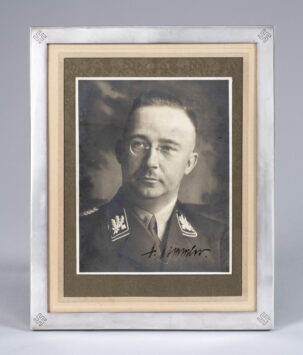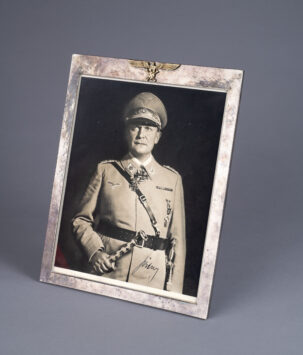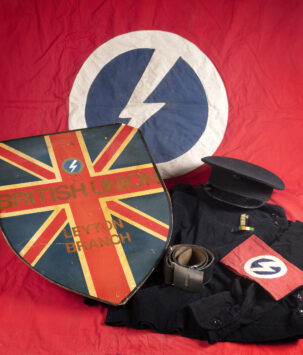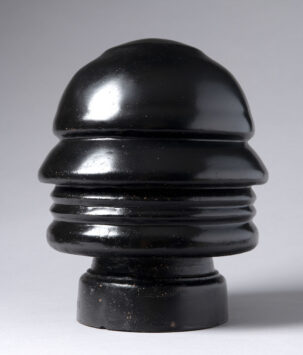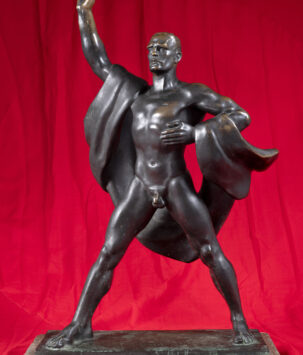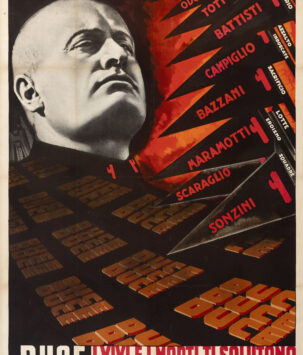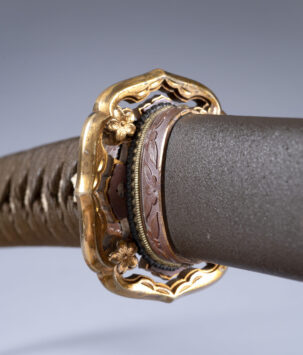Showing 25–36 of 94 results
-
A signed portrait of Reichsführer-SS Heinrich Himmler encased in a period silver frame. As head of the secretive paramilitary organization, the Schutzstaffel (SS), autographs of Himmler are considered exceptionally rare compared to that of more high-profile figures such as Hitler, Göring or other prominent military figures. As overseer of the many concentration camps and the Einsatzgruppen mobile death squads, he served as one of the main architects of the Holocaust. Himmler was guided by his interests in Germanic paganism, mysticism and the occult which he tied to his racialist philosophy in order to create a new, Germanic religion to replace christianity. Such esoteric rituals and symbolisms were incorporated into the SS, with the logo of the SS itself being comprised of two ancient Germanic sig (victory) runes.
-
Signed photograph of Hermann Göring contained within a period presentation frame. Depicts the Reichsmarschall half-length in full dress uniform c. 1940, his marshall’s baton and awards all readily visible. Presumed to be the first official photograph commemorating his 1940 promotion to ‘Reichsmarschall des Grossdeutschen Reiches’. The frame is adorned with an eagle clutching two crossed marshall’s batons and a swastika, a motif often used by the Reichsmarschall.
-
Autographed portrait of diplomat Joachim von Ribbentrop in a dedicated silver frame.
-
Irredentist lithograph by Alberto Martini depicting an ethereal personification of Italy as she stands triumphantly over the Austro-Hungarian Empire. Austria-Hungary is represented by a beastly reptilian interpretation of Emperor Franz-Joseph,, seen claiming rightfully Italian lands for himself.
-
A collection of artifacts from the British Union of Fascists (BUF) including a flag, Leyton branch headquarters plaque, paramilitary peaked cap from the Fascist Defence Force and an officer’s tunic paired with a BUF armband and belt.
Members of the BUF wore the famous black shirt as their uniform, modelled on Sir Oswald Mosley’s fencing tunic. It was stated to be worn because the color best expressed the ‘iron determination’ of Fascism. By eliminating distinctions of dress, it also helped break down of class barriers. The tunics were ideological as well as practical, as in street fights the tunic offered little for an opponent to get a grip on.
-
Profilo continuo del Duce (Continuous profile of the Duce) from 1933 is a Futurist rendition of Mussolini’s distinctive side profile continuing a full 360 degrees. Futurism has been long associated with Fascism, with this sculpture, in its dynamism and movement, typifying Futurist works of art. It was approved as an official portrait by the Duce himself as one of many Futurist political artworks surrounding his cult of personality,
-
Josef Thorak’s sculpture, through its celebration of the triumphant hero, depicts the philosophical antithesis to the coddling liberal notion of celebrating and enabling mediocrity. Sports and athletics took on a national-political character in Nazi Germany, as the cultivation of one’s physical prowess was an indispensable facet in creating the utopian vision of a “New Man” who would harness the ultimate potential of the human race. This will for self-improvement is a central trait in Nietzsche’s concept of a “master-morality” which served as the foundation upon which all fascist ideologies based their political philosophies upon. Nazism, in all its Darwinistic tendencies sought to fashion a new national culture rooted in this so-called “master-morality” to supplant the prevailing Judeo-Christian “slave-morality”.
-
Original maquette of Die Partei (The Party) by the esteemed sculptor Arno Breker, widely considered one of the official artists of the Third Reich. He is known for his monumental works that expressed Nazi ideals of classical beauty, strength, and heroism.
-
Original maquette of Die Wehrmacht (The Armed Forces) by the esteemed sculptor Arno Breker, widely considered one of the official artists of the Third Reich. He is known for his monumental works that expressed Nazi ideals of classical beauty, strength, and heroism.
-
Propaganda poster issued by the Federazione dei Fasci di Combattimento. Text reads: “Duce, The Living and the Dead Greet You With the Cry of the Vigil“
-
Nationalism looks to the past to advise current realities, and Japanese militarists were no different in taking inspiration from the exalted samurai warriors of yore, their revered martial tradition embodied by the katana as seen here. In response to rising nationalist sentiment within the armed forces, a new style of sword was designed for the Japanese military styled after a traditional tachi of the Kamakura Period (1185–1332).
-
Amongst the most iconic posters of the Second World War, an election poster depicting the Führer and bearing the famous nationalist slogan “Ein Volk, ein Reich, ein Führer!” (One people, one realm, one leader!)
